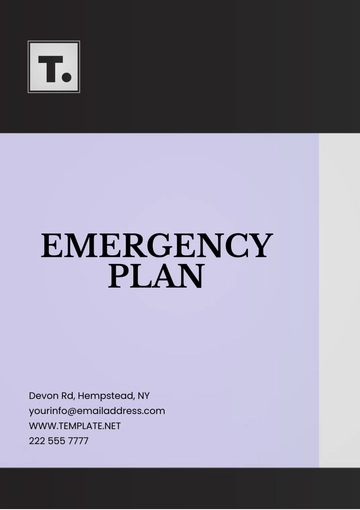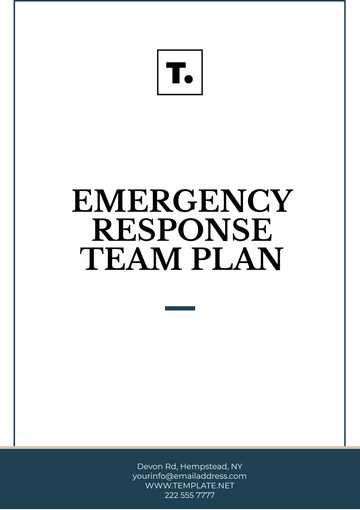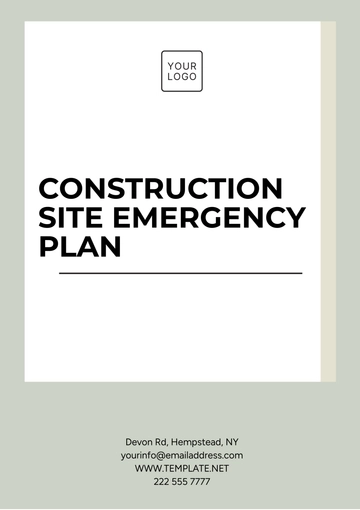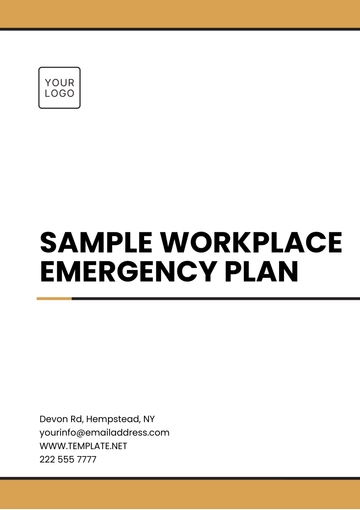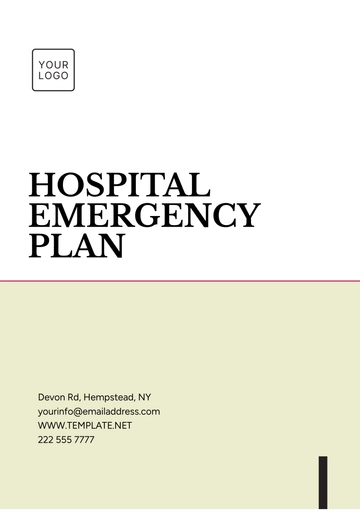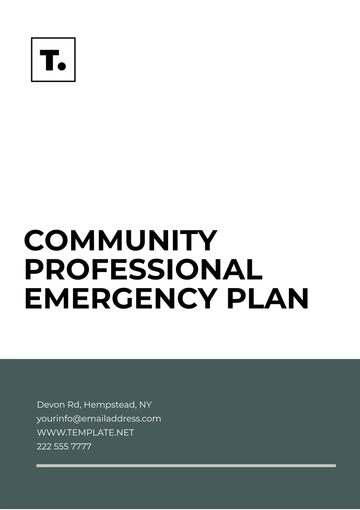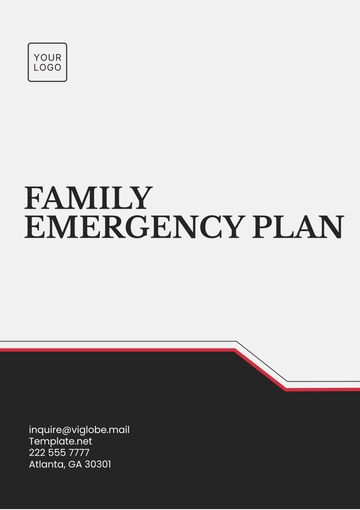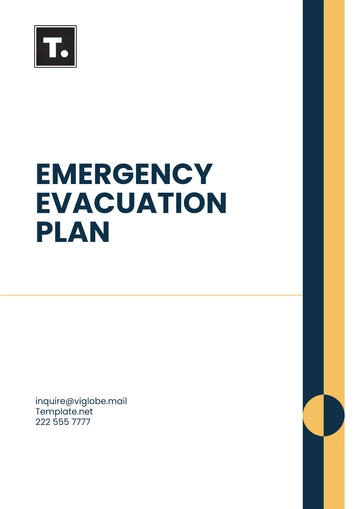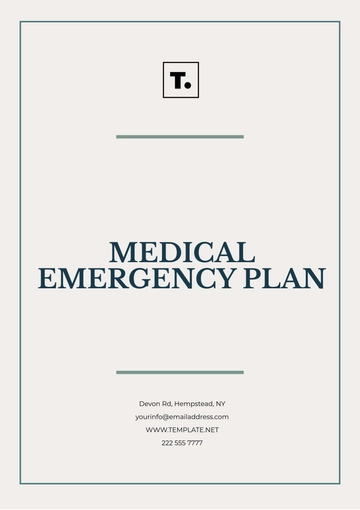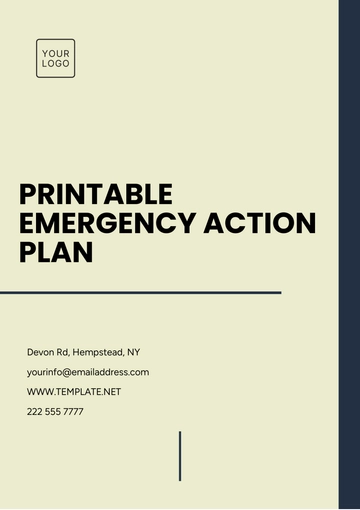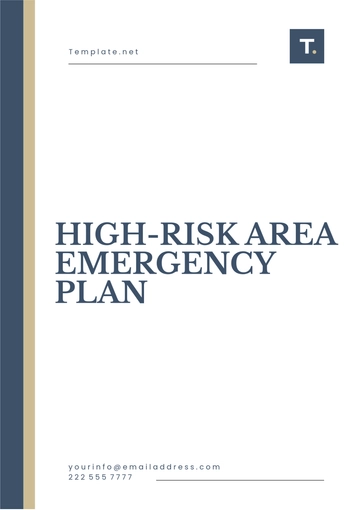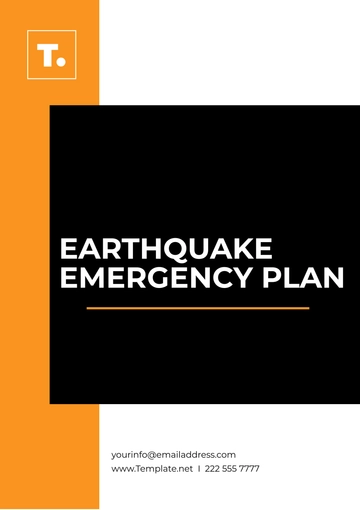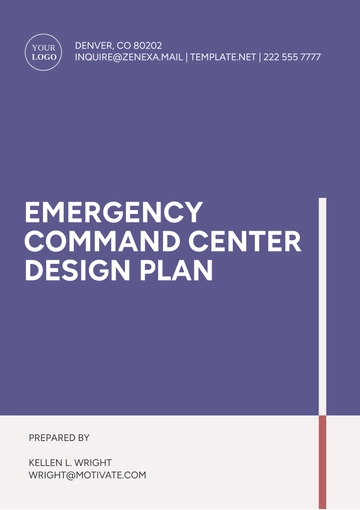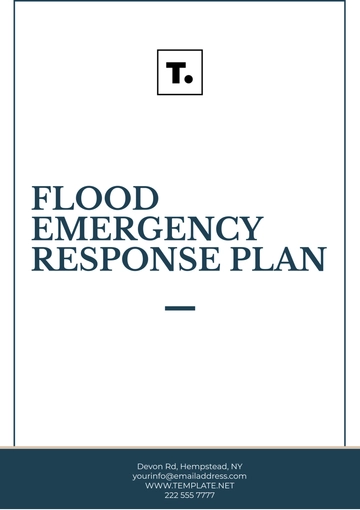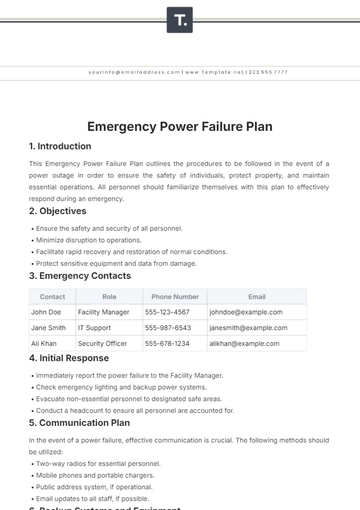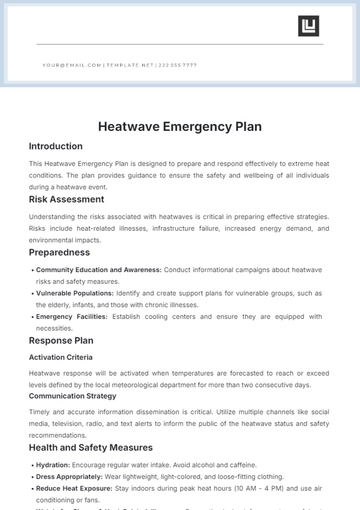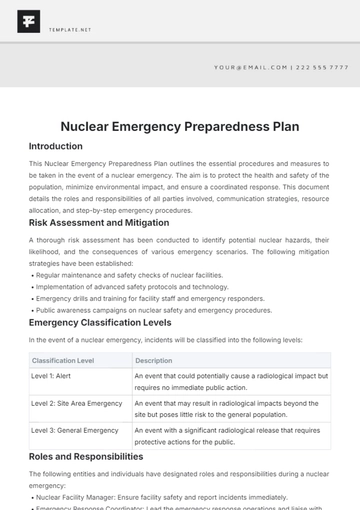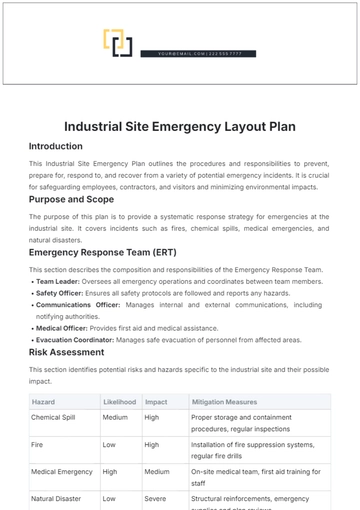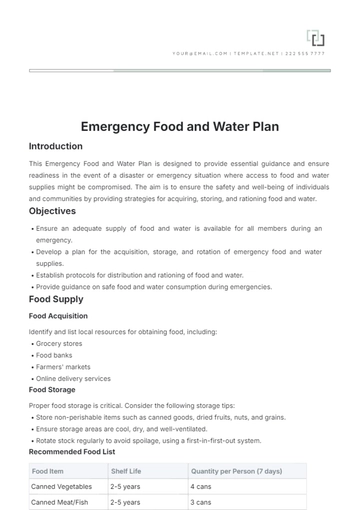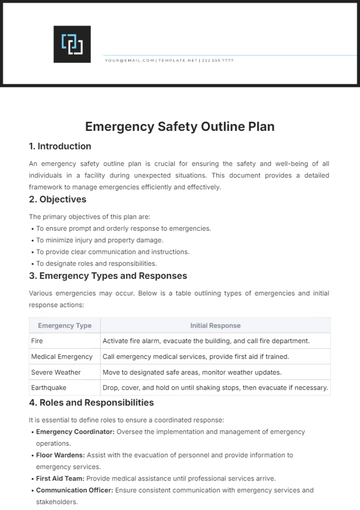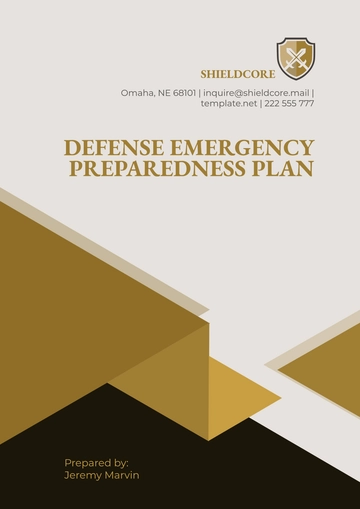Free High-Risk Area Emergency Plan
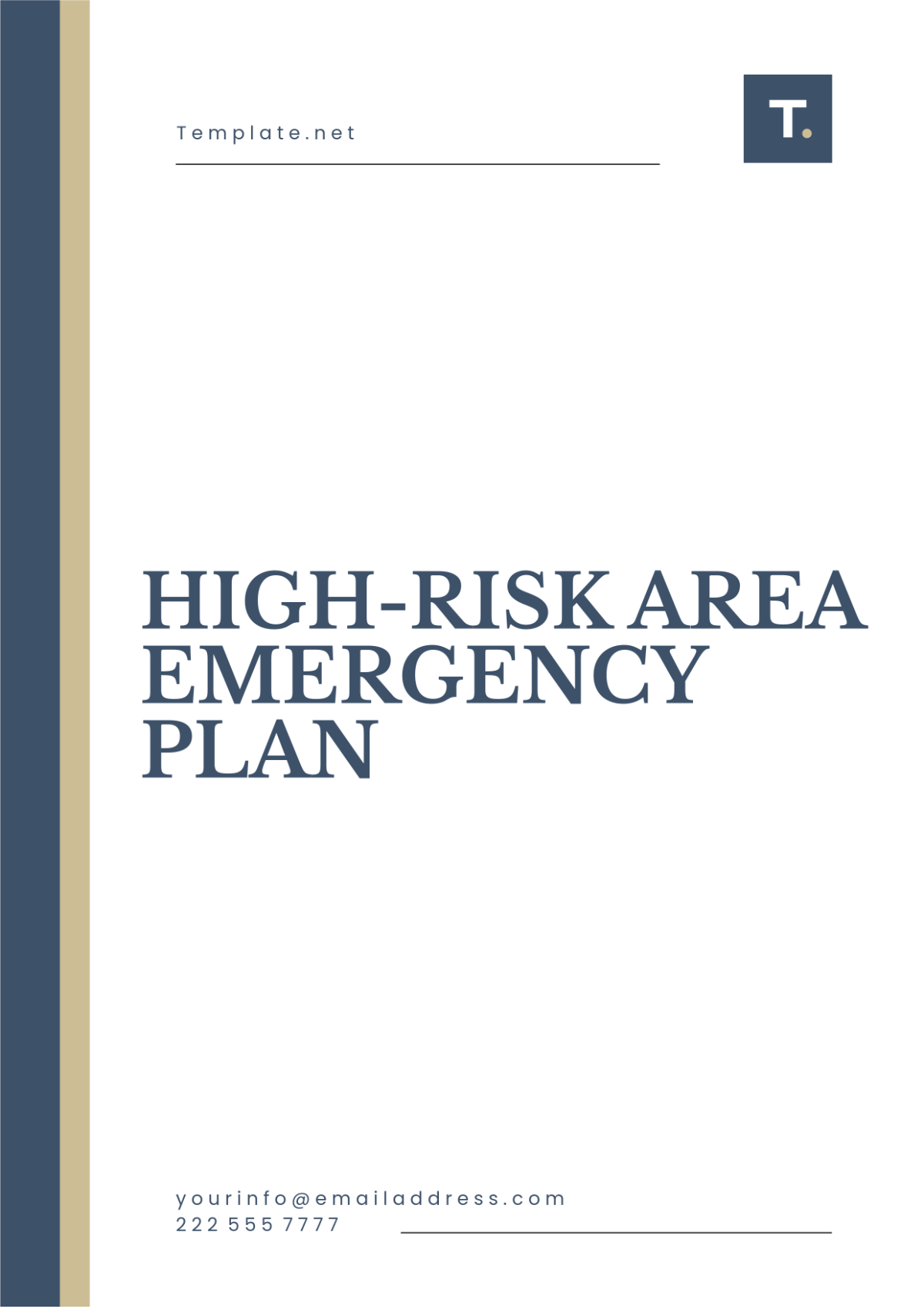
Introduction
This Emergency Plan for High-Risk Areas is designed to ensure the safety and well-being of residents and personnel in regions identified as high-risk due to natural or man-made hazards. This document outlines procedures, responsibilities, and essential contacts necessary for effective emergency response and management.
Risk Assessment
The following table outlines the prevalent risks and their potential impacts in the high-risk area:
Hazard | Potential Impact | Likelihood |
|---|---|---|
Flooding | Damage to infrastructure, displacement of residents | High |
Earthquake | Structural damage, risk of injury | Moderate |
Fire | Property damage, air quality impact | High |
Hazardous Material Spill | Environmental contamination, health risks | Low |
Emergency Response Team
The Emergency Response Team (ERT) is composed of trained professionals tasked with immediate action during crises. Key roles include:
Incident Commander
Safety Officer
Public Information Officer
Operations Section Chief
Logistics Section Chief
Communication Plan
Effective communication is crucial during an emergency. The following protocols will be adhered to:
Emergency Alerts via SMS and email
Community Radio Announcements
Frequent Updates on Social Media Platforms
Coordination with Local Media Outlets
Emergency Contacts:
Fire Department: (123) 456-7890
Police Department: (123) 456-7891
Evacuation Plan
A clear evacuation plan is essential to ensure the safe and orderly movement of residents:
Designated Evacuation Routes:
Route A: Main Street to River Street, exit town through West Gate
Route B: Maple Avenue to Broad Road, exit east through Highway 12
Evacuation Centers:
Community Hall: 123 Community Ln
High School Gym: 456 School Rd
Resource Management
Efficient use and distribution of resources during an emergency:
Emergency Supply Kits:
Water
Non-perishable food
First aid kits
Flashlights
Transportation: Access to public buses and vans
Medical Support: On-site paramedics and first responders
Training and Drills
Regularly scheduled training sessions and evacuation drills for staff and the public to ensure preparedness:
Monthly ERT Training
Quarterly Community Evacuation Drills
Annual Review of Emergency Procedures
Review and Improvement
This plan will be reviewed and updated annually to incorporate new risks, changes in personnel, and improvements based on past emergency responses. Continuous feedback from stakeholders and the community is encouraged to ensure effectiveness.
Conclusion
The safety and resilience of the community in high-risk areas depend on comprehensive planning and active participation from all stakeholders. This Emergency Plan serves as a living document, adapting to new challenges and ensuring readiness to protect lives and property. For questions or recommendations, please contact the Emergency Management Office.
- 100% Customizable, free editor
- Access 1 Million+ Templates, photo’s & graphics
- Download or share as a template
- Click and replace photos, graphics, text, backgrounds
- Resize, crop, AI write & more
- Access advanced editor
High-Risk Area Emergency Plan Template. This customizable template is designed to address specific risks in your environment, ensuring comprehensive emergency protocols. Easily downloadable and printable, it allows for quick access during critical situations. Plus, it’s editable in our AI Editor Tool, enabling you to tailor it to your unique needs. Ensure your team is well-prepared, all offered by Template.net.
You may also like
- Finance Plan
- Construction Plan
- Sales Plan
- Development Plan
- Career Plan
- Budget Plan
- HR Plan
- Education Plan
- Transition Plan
- Work Plan
- Training Plan
- Communication Plan
- Operation Plan
- Health And Safety Plan
- Strategy Plan
- Professional Development Plan
- Advertising Plan
- Risk Management Plan
- Restaurant Plan
- School Plan
- Nursing Home Patient Care Plan
- Nursing Care Plan
- Plan Event
- Startup Plan
- Social Media Plan
- Staffing Plan
- Annual Plan
- Content Plan
- Payment Plan
- Implementation Plan
- Hotel Plan
- Workout Plan
- Accounting Plan
- Campaign Plan
- Essay Plan
- 30 60 90 Day Plan
- Research Plan
- Recruitment Plan
- 90 Day Plan
- Quarterly Plan
- Emergency Plan
- 5 Year Plan
- Gym Plan
- Personal Plan
- IT and Software Plan
- Treatment Plan
- Real Estate Plan
- Law Firm Plan
- Healthcare Plan
- Improvement Plan
- Media Plan
- 5 Year Business Plan
- Learning Plan
- Marketing Campaign Plan
- Travel Agency Plan
- Cleaning Services Plan
- Interior Design Plan
- Performance Plan
- PR Plan
- Birth Plan
- Life Plan
- SEO Plan
- Disaster Recovery Plan
- Continuity Plan
- Launch Plan
- Legal Plan
- Behavior Plan
- Performance Improvement Plan
- Salon Plan
- Security Plan
- Security Management Plan
- Employee Development Plan
- Quality Plan
- Service Improvement Plan
- Growth Plan
- Incident Response Plan
- Basketball Plan
- Emergency Action Plan
- Product Launch Plan
- Spa Plan
- Employee Training Plan
- Data Analysis Plan
- Employee Action Plan
- Territory Plan
- Audit Plan
- Classroom Plan
- Activity Plan
- Parenting Plan
- Care Plan
- Project Execution Plan
- Exercise Plan
- Internship Plan
- Software Development Plan
- Continuous Improvement Plan
- Leave Plan
- 90 Day Sales Plan
- Advertising Agency Plan
- Employee Transition Plan
- Smart Action Plan
- Workplace Safety Plan
- Behavior Change Plan
- Contingency Plan
- Continuity of Operations Plan
- Health Plan
- Quality Control Plan
- Self Plan
- Sports Development Plan
- Change Management Plan
- Ecommerce Plan
- Personal Financial Plan
- Process Improvement Plan
- 30-60-90 Day Sales Plan
- Crisis Management Plan
- Engagement Plan
- Execution Plan
- Pandemic Plan
- Quality Assurance Plan
- Service Continuity Plan
- Agile Project Plan
- Fundraising Plan
- Job Transition Plan
- Asset Maintenance Plan
- Maintenance Plan
- Software Test Plan
- Staff Training and Development Plan
- 3 Year Plan
- Brand Activation Plan
- Release Plan
- Resource Plan
- Risk Mitigation Plan
- Teacher Plan
- 30 60 90 Day Plan for New Manager
- Food Safety Plan
- Food Truck Plan
- Hiring Plan
- Quality Management Plan
- Wellness Plan
- Behavior Intervention Plan
- Bonus Plan
- Investment Plan
- Maternity Leave Plan
- Pandemic Response Plan
- Succession Planning
- Coaching Plan
- Configuration Management Plan
- Remote Work Plan
- Self Care Plan
- Teaching Plan
- 100-Day Plan
- HACCP Plan
- Student Plan
- Sustainability Plan
- 30 60 90 Day Plan for Interview
- Access Plan
- Site Specific Safety Plan
